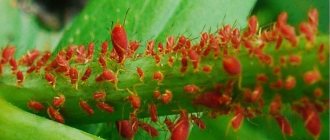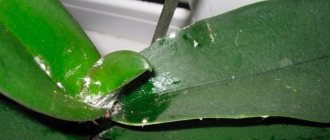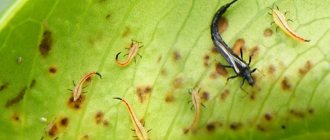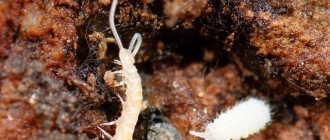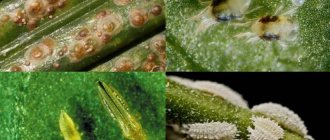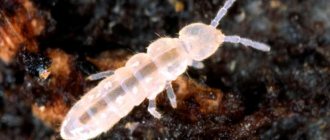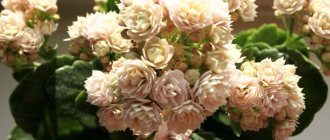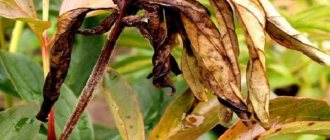Ways of bugs appearing in pots
Most often, it is white bugs that appear on indoor plants. There are a number of ways for beetles to appear in the soil:
- through an open window from the street. This happens if the larvae or adults are on trees;
- poor quality
White bugs in a pot.
the soil that was brought. This problem often arises if the soil for planting is not purchased, but collected;
- soil moisture is too high, which causes rotting;
- various midges and insects that like to lay their eggs in the ground.
Houseplants, pests: how to deal with thrips
When the air in the house is dry, thrips are more likely to appear. The appearance resembles a long striped black fly measuring 1–2 mm. It is easier to detect traces of its sabotage - stripes in the leaf tissue where the larvae are deposited. From a distance they merge into solid spots of a silvery hue.
Since the leaf itself serves as protection for the larvae, these plant pests are also not afraid of contact insecticides. The following measures may affect them:
- Sticky traps (blue and yellow).
- Anti-tick zoo shampoo with permethrin.
- Isolate flowers and buds as this is where thrips are most concentrated.
In no case do not forget to treat all the remaining plants in the house. Even if you treat most of them, the thrips problem will not be solved.
Photo: wikimedia.org: UGC
Types of white beetles in flowers
To determine the method of combating the infestation, it is necessary to understand what type of pests attacked indoor flowers. There are a number of common white beetles that can live in the soil.
What do people advise?
- An infusion of tobacco dust, shag, and red hot pepper is used as a watering solution. Infuse a pound of tobacco waste or shag in 10 liters of water for 48 hours. Add soap shavings (40g) to the strained mixture. The plant itself is sprayed with the finished product and the soil is watered.
- You can also cultivate the soil with a weak solution of potassium permanganate.
- Dry celandine is used. 1 kg of raw materials is poured and infused in water (10 l). The infusion, aged for 24 hours, is filtered. They cultivate the soil.
Radical means of control will not be needed if plant nutrition and watering regime are properly organized and a healthy indoor microclimate is created.
Often, those who deal with indoor plants may notice that some troubles occur with their flowers, for example, white insects have appeared in the ground. How much can these little bugs harm flowers and where do unexpected pests come from?
How can you understand from the initial signs that white insects have infested the flowers? Let's look at these and other questions below.
Prevention measures
To protect indoor flowers from various insects, you need to follow a few simple rules.
- Do not over-moisten the soil; leave it to dry between waterings.
- Monitor air humidity. The room should always have an optimal level of humidity, not excess.
- Periodically inspect indoor flowers for pests. A putrid odor may also be a symptom.
- Periodically water and spray with potassium permanganate.
- All new plants brought in from the street must be quarantined for 14 days.
- When replanting, use only special, purchased soil. And it is even recommended to disinfect it, warm it up or freeze it.
- If pests are found on one of the plants, you need to treat everyone nearby.
Fighting methods
If there are pests in a flower pot, you need to get rid of them urgently. Depending on the degree of damage, choose control methods.
Biological
How to fight harmful insects with biological means? Such preparations are created based on plants. Most often used:
- "Fitoverm";
- "Agrovertin";
- "Iskra-Bio".
Before use, you should read the instructions. Since they destroy pests, they contain poison in small doses. The plants are treated early in the morning and left in a shaded place until all parts of the plant are dry. The room where the treatment was carried out is ventilated. You need to wash all exposed parts of the body with warm water and detergent.
Mechanical
Since white worms live mainly in the soil, mechanical removal is ineffective. You can remove or wash off the adult specimens from the roots, but you will not be able to get rid of the eggs and larvae. If pests have just appeared, replant the indoor plant in healthy, calcined soil. Treat the soil with insecticides. When replanting, remove adult insects, larvae and eggs from the root system. Trim damaged areas and treat with disinfectant solutions.
Chemical
When using chemical pest control products, rapid success can be achieved. It is better to resort to their help as a last resort if other methods have not given a positive result. It should be remembered that such products are unsafe for humans and beneficial insects. You need to work with chemicals with the window open, removing children and animals from the room. In addition, when working you need to use personal protective equipment. After work, you need to thoroughly wash your hands and face. The treated plants are placed in the shade until the solution is completely dry. The area where the treatment was carried out must be washed with hot water and detergents. Remember that chemicals are toxic, therefore, they should be stored in places inaccessible to children and pets. Popular and effective remedies for pests of indoor plants:
- "Karbofos";
- "Chlorophos";
- "Syphos";
- "Trichlorometaphos";
- "Pyrethrum";
- "Decis";
- "Fury."
They are capable of destroying almost all harmful insects.
Traditional methods
If indoor plant pests appear, treatment can be carried out with time-tested folk remedies. For this, decoctions and infusions are prepared from:
- yarrow;
- chamomile;
- dandelion;
- marigolds;
- nettle;
- garlic;
- Luke;
- peels of oranges, tangerines, lemons.
These environmentally friendly and harmless plants can effectively destroy harmful insects. Steamed citrus peels can be buried in the soil. Insects don't like their smell.
An infusion of tobacco, stove ash, a solution of potassium permanganate, furatsilin or soda works well. To prevent the liquid from immediately draining from the plants, laundry soap is added to it.
Tops
- At the very beginning, you can use a decoction of tomato tops.
- It is enough to pour 3-4 kilograms of stepsons from a bush with 10 liters of water, boil half an ace and let it brew for a couple of hours.
- Next, the plants are sprayed with it - the main thing is to first dilute the decoction in a ratio of 1 to 3 with water.
- If desired, you can add laundry soap, this will enhance its effectiveness.
- As an option, you can use potato tops - also an effective folk remedy.
- It’s easier to prepare - just pour boiling water over the tops so that the water covers them and let it brew for 8-10 minutes.
- After straining, you treat the plant without diluting it with water; it is even suitable for daily treatment.
Garlic
- This aromatic spice is often used by gardeners and flower growers to treat plants against a wide variety of insects and pests.
- You can crush a head of garlic in a mortar, then mix it with water in a ratio of 1 to 1 and leave for a week in the refrigerator.
- Next 25 gr. The infusion is diluted in 10 liters of water, spraying the plants with it.
Horsetail
- Its greens, as well as potato tops, are steamed in boiling water, left for 3-5 hours, strain and then the plant itself is sprayed.
- Does not harm the plant, while forming reliable protection around the green space.
- You can not only spray, but also water the soil with this infusion.
Tar soap
- It is used in the form of a soap solution.
- You need to rub a bar of tar soap, dissolve it in a bottle of warm water, shake so that the flakes dissolve and form foam.
- The plant is treated with this foam without washing it off - it forms a protective layer on the green space.
- After some time, you can wash the plant in the shower.
No chemical attacks
Having discovered small populations of insects, you can do without the use of chemical reagents.
- When a springtail is first detected, completely immerse the entire flower along with the pot in water. The floating insects are immediately collected. The plant should not be watered. The top layer of soil (up to 40 mm thick) is removed, and clean, dry sand is poured in its place.
- If podura pests are found in a flowerpot with orchids, the plant is removed from the bark and the roots are washed well with water. The processed rhizome is planted in the whole bark. The rot is cut off and the sections are dried.
- You can dissolve 0.5 tablets of citramone (ascophen) from your home medicine cabinet in 3 liters of water. When watering flowers, use this solution.
- Place the cut potato (cut side down) into the container with the flower. After a while, remove the vegetable along with the podurs that have penetrated into it.
- Dry lemon and orange skins and place them in pots with plants. Insects cannot stand the smell of citrus fruits and “leave.”
- Do not water the soil with a solution containing decomposing organic matter: milk, tea or coffee, etc.
- The soil and green areas are dusted with wood ash. Crushed into powder, it is sprinkled on the soil with a layer of 10 mm with scanty watering.
- Dry mustard is also used for dusting. Powder is sprinkled on the soil in a pot with a layer thickness of 10 mm with limited watering.
- Water with a solution: 40 g of grated laundry soap, pour 1 liter of water and dissolve.
- Dry mustard (10 g) is silted with water (1 l) at a temperature of 60°C. The solution is infused for 48 hours, after which it is filtered. Used for treating flower seeds before planting.
- The same mustard (1 tsp) is diluted in 1 liter of water. This is how the composition is prepared for watering and simultaneously destroying other pests.
Drastic measures
Some types of bugs affect not only flowers, stems and leaves of plants, but also the root system. Therefore, if you notice that pests are present in the soil, you will need to take drastic measures. First, take a new substrate. Then remove the affected house flowers from their pots and carefully remove the soil. It is advisable to rinse them under running water. If some leaves and buds of plants are too badly damaged by bugs, then it is best to break them off.
Dilute the Aktara chemical according to the instructions on the package and spray each plant with the resulting solution. Then fill the thoroughly washed pots with new substrate and plant the treated flowers in them. Be sure to add a small amount of calcined sand on top (you can use regular ash). Water the plants with soapy water and place them on the windowsills. After a week, re-treat them with Aktara.
Remember that when using chemicals you must wear a respirator, goggles and gloves. This will protect your hands and mucous membranes from their harmful effects. The treatment itself is best done in the fresh air.
To be fair, it should be noted that only some species of collembola are classified as pests. But there are springtails that eat nematodes and enchytraeids, thereby bringing benefits. Insects feeding on rotting organic matter improves soil formation. The white fool is one of those four species of “brothers” that stand out for their harmfulness from the more than 4 thousand that live on earth. We can talk about the danger of insects in the case of a sharp growth of the colony, when there is not enough rotting residue in the pots to feed, and the thinnest thread-like roots of the root system begin to be eaten. Most often, orchids, violets, and gloxinias fall into the risk zone.
Attention! The appearance of springtails in indoor flowers is an indicator of waterlogged soil in pots and flowerpots and improper care of plants.
